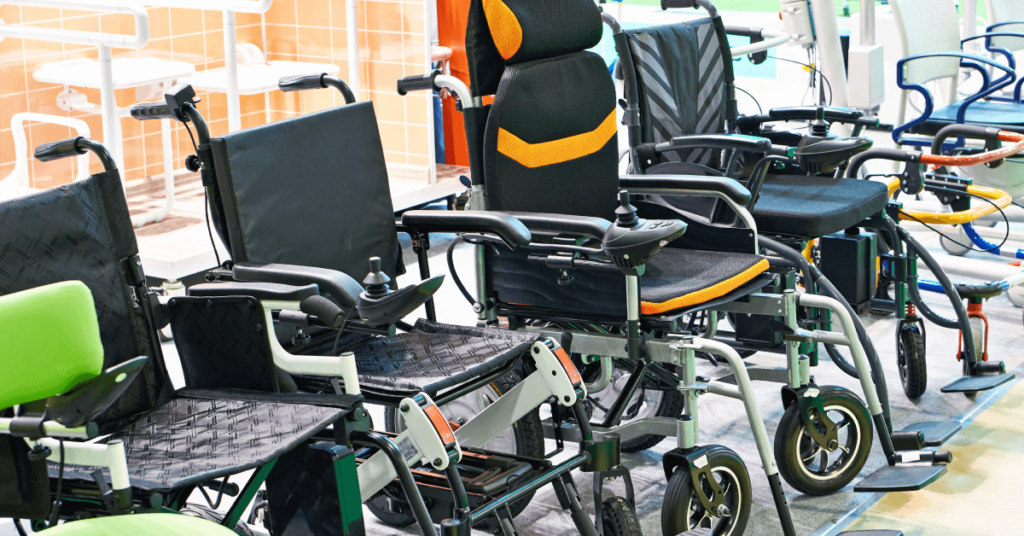Type 1 to Type 5 Wheelchairs Explained & How Each Type Serves Specific Mobility Needs
Saturday, January 20th, 2024, 6:54 am , Posted by MED +
When it comes to mobility solutions, wheelchairs play an integral role in providing independence and improving the quality of life for millions worldwide. Understanding the differences between wheelchair types is key to selecting the right one for specific needs. This guide delves into the five primary types of wheelchairs, their unique features, and the mobility challenges they address.
Type 1: Standard Wheelchairs
Standard wheelchairs are the most commonly recognized type. Designed for individuals with temporary or long-term mobility issues, they are straightforward, durable, and cost-effective.
Key Features:
- Weight: Typically heavier due to their steel construction.
- Mobility: User-operated via hand rims or caregiver assistance.
- Comfort: Basic cushioning with minimal adjustments.
- Usage: Ideal for short-term needs, such as post-surgery recovery or occasional outings.
Who Benefits:
Standard wheelchairs suit users who do not require frequent customization or prolonged daily use. They’re a reliable option for those who have caregivers or limited upper-body strength to self-propel.
Type 2: Lightweight and Ultralight Wheelchairs
For users needing greater maneuverability and portability, lightweight and ultralight wheelchairs are game-changers.
Key Features:
- Weight: Aluminum or composite frames reduce weight significantly (15-30 lbs).
- Mobility: Easier to self-propel and transport.
- Customization: Adjustable footrests, backrests, and seating options.
- Usage: Frequent use, both indoors and outdoors.
Who Benefits:
These wheelchairs cater to active individuals who require a reliable yet portable solution. They’re ideal for those managing chronic conditions requiring daily wheelchair use or frequent travel.
Type 3: Power Wheelchairs
Power wheelchairs represent a leap in mobility technology, using electric motors to provide effortless movement.
Key Features:
- Control: Operated via joystick or specialized controls for individuals with limited dexterity.
- Power: Battery-powered with ranges between 10-25 miles per charge.
- Comfort: Enhanced seating systems, adjustable armrests, and headrests.
- Usage: All-day mobility for indoor and outdoor environments.
Who Benefits:
Power wheelchairs are perfect for individuals with severe mobility impairments, limited upper-body strength, or progressive conditions such as ALS or MS. They provide independence and reduce physical strain.
Type 4: Sports Wheelchairs
Designed for performance and agility, sports wheelchairs enable users to participate in athletic activities and competitive sports.
Key Features:
- Structure: Lightweight frames with a unique design for speed and maneuverability.
- Mobility: Specialized wheels and low-profile seating for enhanced control.
- Customization: Tailored to specific sports like basketball, tennis, or racing.
- Usage: Athletic training and competition.
Who Benefits:
These wheelchairs are for active individuals with a passion for sports. They’re engineered for both recreational and professional athletes, fostering inclusivity in athletics.
Type 5: Pediatric Wheelchairs
Pediatric wheelchairs address the unique needs of children requiring mobility assistance, offering functionality, growth adaptability, and a touch of fun.
Key Features:
- Size: Smaller frames and components to suit children’s proportions.
- Customization: Adjustable seating, supportive harnesses, and growth-accommodating features.
- Mobility: Manual or powered options for diverse needs.
- Design: Vibrant colors and engaging designs to appeal to younger users.
Who Benefits:
Children with mobility challenges due to conditions like cerebral palsy or muscular dystrophy benefit from these wheelchairs. They’re essential for both independence and development.
Choosing the Right Wheelchair
Selecting the right wheelchair involves considering several factors:
- Mobility Needs: Does the user require manual or powered assistance?
- Lifestyle: Is the wheelchair for occasional or daily use? Indoor or outdoor use?
- Physical Condition: Strength, posture, and specific medical requirements.
- Portability: How often will the wheelchair be transported?
- Budget: Weighing upfront costs against long-term benefits.
At MED+ Medical Equipment Distribution Inc., our team specializes in matching users with the perfect wheelchair for their unique needs. With over 25 years of experience, we’re committed to empowering individuals with mobility solutions that enhance their quality of life.
From standard to specialized models, each type of wheelchair serves a distinct purpose. Understanding these differences ensures that users can confidently choose a wheelchair that supports their independence and lifestyle. Whether you’re recovering from an injury, managing a chronic condition, or striving for athletic goals, there’s a wheelchair designed for you.
Explore our extensive range of mobility solutions at MED+ Medical Equipment Distribution Inc. and discover how we can help you or your loved ones regain mobility and confidence.
Browse Blog Topics
- MED+ Partners with Holmes on Homes: Building a Legacy
- 7 Reasons Why a Hospital Bed Could Be a Good Investment for Improved Home Care of a Loved One
- 8 Ways to Make a Home Wheelchair Accessible
- Walkers vs. Rollators: Which is Right for You?
- 5 Ways MED+ Works with Occupational Therapists to Enhance Mobility & Accessibility for Patients





